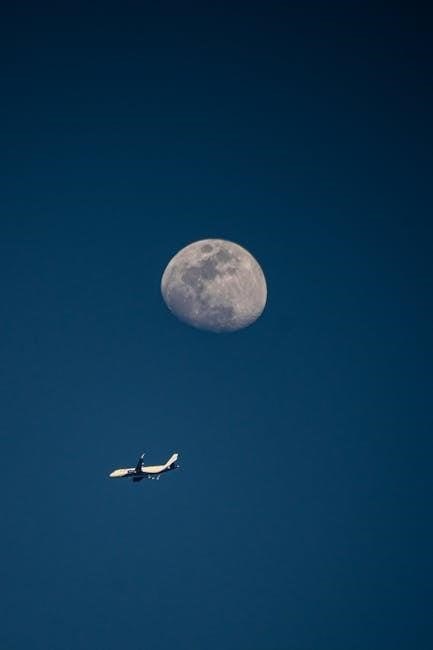fly me to the moon piano pdf
“Fly Me to the Moon” is a timeless jazz standard popularized by Frank Sinatra, capturing the essence of romance and longing with its elegant melody and poetic lyrics.
Overview of the Song and Its Popularity
“Fly Me to the Moon,” composed by Bart Howard in 1954, is a timeless jazz standard that has captivated audiences with its romantic essence and soaring melody. Popularized by Frank Sinatra, the song became an iconic piece in his repertoire, blending lush orchestration with heartfelt vocals. Its universal appeal lies in its ability to evoke emotions, making it a favorite across generations. The track’s popularity soared in the 1960s, and it remains a staple in jazz and pop culture. Its versatility has led to numerous covers by artists worldwide, further cementing its legacy. The song’s association with space exploration, including being played during the Apollo missions, adds to its historical significance. Today, “Fly Me to the Moon” continues to inspire musicians and remains a beloved choice for piano arrangements, with sheet music widely available in PDF formats for enthusiasts to enjoy.
Frank Sinatra’s Iconic Version and Its Impact
Frank Sinatra’s rendition of “Fly Me to the Moon” is widely regarded as the definitive version, catapulting the song to unparalleled heights. Recorded in 1964 with Count Basie and his orchestra, Sinatra’s smooth, velvety vocals and the band’s swinging arrangement transformed the track into a timeless classic. This collaboration not only showcased Sinatra’s interpretive genius but also solidified the song’s place in the Great American Songbook. The version’s impact was immense, resonating with audiences globally and influencing countless artists. Its success led to the song being featured in films, TV shows, and even space exploration, embedding it deeply in popular culture; Sinatra’s “Fly Me to the Moon” remains a benchmark for vocal excellence and musical artistry, continuing to inspire new generations of musicians and fans alike. Its enduring legacy is a testament to the power of timeless music.
The Timeless Appeal of the Song in Modern Music

“Fly Me to the Moon” continues to captivate audiences with its timeless charm, making it a staple in modern music. Its elegant melody and romantic lyrics transcend generations, appealing to both retro and contemporary listeners. The song’s versatility allows it to be reimagined in various genres, from jazz and pop to electronic and classical, ensuring its relevance in today’s diverse musical landscape. Its presence in films, TV shows, and even space exploration highlights its enduring appeal. With the rise of digital platforms, the song’s piano sheet music remains widely sought after, enabling new artists to interpret and share it. This timeless classic continues to inspire musicians and fans alike, proving its lasting impact on music and culture. Its adaptability and emotional resonance ensure it will remain a beloved piece for years to come.

Background and History of “Fly Me to the Moon”
“Fly Me to the Moon,” originally titled “In Other Words,” was written by Bart Howard in 1954. It evolved into a jazz standard, gaining fame through Frank Sinatra’s iconic 1964 recording with Count Basie, becoming one of Sinatra’s signature songs.
The Composer: Bart Howard and His Inspiration
Bart Howard, an American composer and pianist, wrote “Fly Me to the Moon” in 1954 under its original title, “In Other Words.” Howard’s inspiration stemmed from a romantic, poetic vision of escapism and love, encapsulated in the song’s lyrical imagery of flying to the moon.
Initially intended as a slow ballad, the song’s melody and lyrics resonated deeply, evolving into a timeless jazz standard. Howard’s composition showcased his ability to blend sophisticated harmonies with heartfelt emotion, making it a favorite among vocalists and instrumentalists alike.
The song’s enduring appeal lies in its universal themes of longing and romance, which Howard masterfully wove into its structure. His work on “Fly Me to the Moon” remains a testament to his skill as a composer and his lasting influence on jazz and popular music.
Frank Sinatra’s Collaboration and Recording
Frank Sinatra’s 1964 collaboration with Count Basie and his orchestra elevated “Fly Me to the Moon” to iconic status. His smooth, velvety voice and the swinging arrangement transformed the song into a quintessential jazz standard.
Sinatra’s rendition, conducted by Neal Hefti, featured a lively tempo and lush orchestration, capturing the essence of romance and sophistication. The recording became a signature piece in Sinatra’s repertoire, further cementing his legacy as a legendary interpreter of timeless songs.
This version’s success highlighted Sinatra’s ability to reimagine and personalize compositions, making “Fly Me to the Moon” indelibly linked to his artistic identity. His collaboration not only popularized the song but also showcased his enduring impact on jazz and popular music.
Evolution of the Song in Jazz and Popular Culture
“Fly Me to the Moon” has evolved into a timeless jazz standard, transcending generations through its interpretations by various artists. Originally written by Bart Howard in 1954 as “In Other Words,” the song gained widespread popularity after Frank Sinatra’s iconic 1964 recording with Count Basie, which remains the most recognizable version.
Over the years, the song has been covered by numerous artists, from jazz legends like Ella Fitzgerald and Louis Armstrong to contemporary performers, showcasing its versatility. Its presence in films, TV shows, and media has further cemented its place in popular culture, introducing it to new audiences.
The song’s timeless appeal lies in its romantic and poetic lyrics, coupled with its soaring melody, making it a staple in jazz and beyond. Its evolution reflects its ability to adapt to changing musical styles while retaining its emotional core, ensuring its enduring legacy in music history.

Sheet Music and Piano Arrangements
The sheet music for “Fly Me to the Moon” is widely available as PDF downloads, offering piano, guitar, and trumpet arrangements on platforms like MuseScore and Piano Nifty.
Availability of “Fly Me to the Moon” Piano PDF
The piano PDF for “Fly Me to the Moon” is widely available online, with numerous platforms offering free and premium downloads. Websites like MuseScore, Piano Nifty, and SheetMusic-Free.com provide high-quality arrangements. Many versions include piano, vocal, and guitar scores, catering to diverse musical preferences. Some platforms require memberships for full access, while others offer free downloads in PDF or MIDI formats. The sheet music is often transposable, allowing customization to different keys. Additionally, interactive scores and digital versions enhance learning and performance. This accessibility ensures that musicians of all levels can enjoy playing this timeless classic. The ease of downloading and printing makes it a favorite among pianists worldwide, preserving its legacy as a beloved jazz standard.
Structure and Notation in the Sheet Music
The sheet music for “Fly Me to the Moon” features a clear and structured notation, making it accessible to pianists of various skill levels. The score typically includes the melody, harmony, and chords, arranged in a standard jazz format. The notation is often presented in key signatures such as C minor, with detailed markings for dynamics, tempo, and articulation. Many versions include intro, verse, solo, and chorus sections, providing a comprehensive guide for performance. The sheet music also frequently incorporates Bossa Nova influences, adding rhythmic complexity. Advanced arrangements may feature intricate improvisational sections, while simplified versions focus on the core melody. This structured approach ensures that both beginners and experienced musicians can interpret the song effectively, maintaining its timeless appeal and musical richness.
Popular Platforms for Downloading the Sheet Music
Several platforms offer high-quality PDF sheet music for “Fly Me to the Moon.” MuseScore and Musicnotes provide premium access to official scores, while Piano Nanny offers free arrangements. Sheet Music Plus and Pianotify also feature downloadable versions. These platforms cater to diverse needs, with options for transposable scores, interactive viewing, and multiple instrument arrangements. Many sites include free and paid versions, ensuring accessibility for all musicians. These resources make it easy to find and download the perfect sheet music for practice or performance, maintaining the song’s timeless appeal for pianists worldwide.

Learning to Play “Fly Me to the Moon” on the Piano
Mastering the melody and harmony requires a steady tempo and rhythmic precision. Start with a slow practice to understand the jazz timing. Use a metronome for consistency.
Beginner-Friendly Tips for Mastering the Melody
Learning the melody of “Fly Me to the Moon” can be simplified by breaking it into smaller sections. Start with the verse, focusing on the right-hand melody while keeping a steady tempo with the left-hand chords. Use a metronome to maintain rhythm and gradually increase speed as confidence grows. Emphasize dynamics, as the song’s feel relies on subtle variations in volume and expression. Practice scales and arpeggios to strengthen finger dexterity. Utilize online resources like MuseScore or Piano Nanny for interactive sheet music and tutorials. Record yourself to track progress and identify areas for improvement. Most importantly, relax and enjoy the process of mastering this timeless piece.
Advanced Techniques for Jazz Improvisation
Mastering advanced jazz improvisation on “Fly Me to the Moon” involves exploring complex harmonies and rhythmic variations. Start by analyzing the song’s chord progression, focusing on the ii-V-I sequence in the key of C minor. Experiment with modal interchange, incorporating chords and scales from parallel keys to add depth. Use chromatic runs and syncopation to create intricate melodic lines. Emphasize blue notes and altered dominants to give your improvisation a authentic jazz feel. Practice trading fours or eights with a partner to refine your phrasing. Study transcriptions of legendary jazz pianists like Bill Evans or Oscar Peterson for inspiration. Incorporate advanced techniques like reharmonization and motivic development to elevate your solos. Remember, the key to great improvisation is balancing spontaneity with a deep understanding of the song’s structure and emotional essence.
Recommended Tools and Resources for Practice
To effectively practice and master “Fly Me to the Moon” on the piano, utilize high-quality resources like MuseScore, which offers detailed sheet music and interactive scores. Piano Nanny provides excellent video tutorials for both beginners and advanced players. For a more immersive experience, use digital audio workstations (DAWs) like GarageBand or FL Studio to loop sections and practice improvisation. Metronome apps, such as Tempo, help refine timing and rhythm. Additionally, platforms like Piano Marvel and Skoove offer guided lessons tailored to jazz standards. Sheet music apps like forScore enable annotation and organization of your PDF scores. Finally, explore YouTube channels dedicated to jazz piano for inspiration and advanced techniques. These tools will enhance your practice routine and help you achieve a polished performance of this timeless classic.

Cultural and Historical Significance
“Fly Me to the Moon” holds a special place in history as one of the first songs played in space, symbolizing its universal appeal and timeless charm.
The Song’s Role in Space Exploration
“Fly Me to the Moon” made history as one of the first songs played in outer space during the Apollo 10 mission. This iconic moment symbolized the song’s universal appeal and its ability to transcend earthly bounds. The track’s romantic and exploratory themes resonated deeply with astronauts and the public alike, marking a unique intersection of music and space exploration. Its inclusion in this historic event further cemented its legacy, showcasing how art can accompany human achievements. The song’s journey to space not only highlighted its timeless charm but also demonstrated its power to inspire wonder and curiosity. This milestone remains a testament to its enduring cultural significance and its place in the annals of history.
Usage in Films, TV Shows, and Media
“Fly Me to the Moon” has been a staple in films, TV shows, and media, enhancing emotional moments with its timeless charm. Featured in movies like Apollo 10 1/2: A Space Age Childhood, it evokes nostalgia and romance. TV series often incorporate the song to create memorable scenes, leveraging its smooth melody. Its iconic status makes it a popular choice for advertisements, connecting with audiences globally. Frank Sinatra’s version is frequently used, adding sophistication to various narratives. The song’s versatility in media underscores its enduring appeal, making it a cultural treasure that continues to resonate across generations. Its presence in films and TV shows ensures its legacy endures, introducing it to new audiences while delighting long-time fans. This widespread usage highlights its universal relevance and emotional depth.
Legacy of Frank Sinatra and His Music
Frank Sinatra’s rendition of “Fly Me to the Moon” cemented his status as a legendary vocalist, leaving an indelible mark on music history. His smooth, velvety voice and interpretive skills brought depth to the song, making it a hallmark of his repertoire. Sinatra’s collaboration with Count Basie and his orchestra further elevated the track, blending jazz and pop seamlessly. The song became a cornerstone of his live performances and recordings, showcasing his ability to transform lyrics into emotional narratives. Sinatra’s legacy extends beyond “Fly Me to the Moon,” as he remains one of the most influential artists of the 20th century, inspiring generations of musicians and fans alike. His music, including this timeless classic, continues to resonate, ensuring his enduring impact on popular culture.
“Fly Me to the Moon” remains a timeless classic, with Frank Sinatra’s iconic version and Bart Howard’s composition leaving a lasting legacy in music history. Its availability as a piano PDF ensures its continued celebration and interpretation by new generations of musicians and fans alike.
Final Thoughts on the Song’s Enduring Legacy
“Fly Me to the Moon” is a testament to timeless elegance and emotional depth in music. Frank Sinatra’s rendition elevated it to iconic status, making it a staple in jazz and popular culture. Its romantic lyrics and soaring melody continue to resonate with audiences, transcending generations. The song’s legacy is further cemented by its role in space exploration, being one of the first tunes played in outer space. Its adaptability across genres and arrangements ensures its relevance, from intimate piano solos to grand orchestral performances. The availability of “Fly Me to the Moon” as a piano PDF has made it accessible to musicians worldwide, allowing its beauty to be reinterpreted and cherished by new artists and fans alike. It remains a celebration of love, wonder, and the universal language of music.
Encouragement to Explore and Play the Song
Exploring and playing “Fly Me to the Moon” is a rewarding journey for musicians of all levels. The song’s timeless melody and romantic lyrics make it a joy to interpret, whether you’re a beginner or an experienced pianist. With the availability of high-quality piano PDF sheet music, you can easily access arrangements tailored to your skill level. From simple melodies to intricate jazz improvisations, this song offers endless opportunities for creativity. Embrace the challenge of mastering its harmonies and rhythms, and let the emotional depth of the music shine through your performance. Playing “Fly Me to the Moon” not only connects you to its rich legacy but also allows you to share its beauty with others. Start your musical journey today and let this iconic song inspire you to new heights.